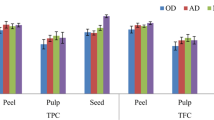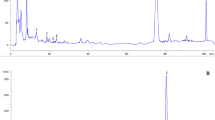Abstract
This study aimed to investigate the effect of different extraction solvents and determine the optimum solvent concentration (in the range of 0–100%) for the recovery of total phenolic content, total flavonoid content and antioxidant capacity of peel, pulp and seed kernel of Mangifera odorata fruit. The total phenolic (TPC) and total flavonoid content (TFC) were determined using Folin–Ciocalteu and aluminum chloride assays, respectively. The highest level of TPC was found in 60% and 80% (v/v) acetone for pulp and seed kernel while peel showed the highest TPC at the concentration of 80% (v/v) acetone. The optimum total flavonoid content was achieved at 100% (v/v) methanol for all fruit parts. Antioxidant activity was measured using ferric reducing antioxidant power assay, and the result showed the highest activity at 60% (v/v) ethanol for all parts of M. odorata fruit. The highest scavenging activity was shown at 60% (v/v) acetone for pulp and seed kernel, respectively. Peel exhibited the highest scavenging activity at 40% acetone. It can be concluded that the recovery of phenolic compounds was dependent on the polarity of the chemical constituents in the different parts of fruit as well as the polarity of the solvent systems used. Seed kernel had the highest TPC, TFC and possessed excellent antioxidant capacity compared to peel and pulp of M. odorata. Therefore, the seed kernel can be incorporated into food products as a functional ingredient for the prevention of oxidative-stress related diseases.


Similar content being viewed by others
References
Addai ZR, Abdullah A, Mutalib SA (2013) Effect of extraction solvents on the phenolic content and antioxidant properties of two papaya cultivars. J Med Plants Res 7(46):3354–3359
Ahmadi F, Kadivar M, Shahedi M (2007) Antioxidant activity of Kelussia odoratissima Mozaff. in model and food systems. Food Chem 105(1):57–64
Alasalvar C, Karamać M, Amarowicz R, Shahidi F (2006) Antioxidant and antiradical activities in extracts of hazelnut kernel (Corylus avellana L.) and hazelnut green leafy cover. J Agric Food Chem 54(13):4826–4832
Al-Farsi MA, Lee CY (2008) Nutritional and functional properties of dates: a review. Crit Rev Food Sci Nutr 48(10):877–887
Benzie IF, Strain JJ (1996) The ferric reducing ability of plasma (FRAP) as a measure of “antioxidant power”: the FRAP assay. Anal Biochem 239(1):70–76
Bhaigyabati T, Devi PG, Bag GC (2014) Total flavonoid content and antioxidant activity of aqueous rhizome extract of three hedychium species of Manipur valley. Res J Pharm Biol Chem Sci 5(5):970–976
Boeing JS, Barizão ÉO, e Silva BC, Montanher PF, de Cinque Almeida V, Visentainer JV (2014) Evaluation of solvent effect on the extraction of phenolic compounds and antioxidant capacities from the berries: application of principal component analysis. Chem Cent J 8(1):1–9
Chirinos R, Rogez H, Campos D, Pedreschi R, Larondelle Y (2007) Optimization of extraction conditions of antioxidant phenolic compounds from mashua (Tropaeolum tuberosum Ruíz & Pavón) tubers. Sep Purif Technol 55(2):217–225
Cottica SM, Sawaya AC, Eberlin MN, Franco SL, Zeoula LM, Visentainer JV (2011) Antioxidant activity and composition of propolis obtained by different methods of extraction. J Braz Chem Soc 22(5):929–935
de Sousa SHB, de Andrade Mattietto R, Chisté RC, Carvalho AV (2018) Phenolic compounds are highly correlated to the antioxidant capacity of genotypes of Oenocarpus distichus Mart. fruits. Food Res Int 108:405–412
Dhanani T, Shah S, Gajbhiye NA, Kumar S (2017) Effect of extraction methods on yield, phytochemical constituents and antioxidant activity of Withania somnifera. Arab J Chem 10:S1193–S1199
Do QD, Angkawijaya AE, Tran-Nguyen PL, Huynh LH, Soetaredjo FE, Ismadji S, Ju YH (2014) Effect of extraction solvent on total phenol content, total flavonoid content, and antioxidant activity of Limnophila aromatica. J Food Drug Anal 22(3):296–302
Dorta E, Lobo MG, Gonzalez M (2012) Reutilization of mango byproducts: study of the effect of extraction solvent and temperature on their antioxidant properties. J Food Sci 77(1):C80–C88
Downey MO, Hanlin RL (2016) Comparison of ethanol and acetone mixtures for extraction of condensed tannin from grape skin. S Afr J Enol Vitic 31(2):154–159
Ghazi F, Rahmat A, Yassin Z, Ramli NS, Buslima NA (2012) Determination of total polyphenols and nutritional composition of two different types of Ficus carica leaves cultivated in Saudi Arabia. Pak J Nutr 11(11):1061–1065
Guo C, Yang J, Wei J, Li Y, Xu J, Jiang Y (2003) Antioxidant activities of peel, pulp and seed fractions of common fruits as determined by FRAP assay. Nutr Res 23(12):1719–1726
Halliwell B (1991) Reactive oxygen species in living systems: source, biochemistry, and role in human disease. Am J Med 91(3):S14–S22
Ikram EHK, Eng KH, Jalil AMM, Ismail A, Idris S, Azlan A, Mokhtar RAM (2009) Antioxidant capacity and total phenolic content of Malaysian underutilized fruits. J Food Compost Anal 22(5):388–393
Institute for Public Health (2015) National health and morbidity survey 2015 (NHMS 2015) Volume III: Non-communicable disease. Ministry of Health, Kuala Lumpur
Khoo HE, Ahmad I (2008) Determination of daidzein and genistein contents in mangifera fruit. Malays J Nutr 14(2):189–198
Khoo HE, Ismail A, Mohd Esa N, Idris S (2008) Carotenoid content of underutilized tropical fruits. Plant Foods Hum Nutr 63:170–175
Kothari V, Seshadri S (2010) Antioxidant activity of seed extracts of Annona squamosa and Carica papaya. Nutr Food Sci 40(4):403–408
Lafka TI, Sinanoglou V, Lazos ES (2007) Extraction and antioxidant activity of phenolic compounds from winery wastes. Food Chem 104(3):1206–1214
Lasano NF, Hamid AH, Karim R, Dek MSP, Shukri R, Shazini Ramli N (2019) Nutritional composition, anti-diabetic properties and identification of active compounds using UHPLC-ESI-orbitrap-MS/MS in Mangifera odorata L. peel and seed kernel. Molecules 24(2):320–340
Lien DTP, Tram PTB, Toan HT (2015) Effects of extraction process on phenolic content and antioxidant activity of soybean. J Food Nutr Sci 3(1–2):33–38
Lim TK (2012) Mangifera odorata. In: Lim TK (ed) Edible medicinal and non-medicinal plants, vol 1. Springer, Amsterdam, pp 127–130
Lu Y, Foo LY (1999) The polyphenol constituents of grape pomace. Food Chem 65(1):1–8
Luximon-Ramma A, Bahorun T, Crozier A (2003) Antioxidant actions and phenolic and vitamin C contents of common Mauritian exotic fruits. J Sci Food Agric 83(5):496–502
Magalhães LM, Segundo MA, Reis S, Lima JL (2006) Automatic method for determination of total antioxidant capacity using 2, 2-diphenyl-1-picrylhydrazyl assay. Anal Chim Acta 558(1):310–318
Mahidin U (2018) Statistics on causes of death Malaysia. Department of Statistics Malaysia https://www.dosm.gov.my/v1. Accessed 13 June 2019
Meneses NG, Martins S, Teixeira JA, Mussatto SI (2013) Influence of extraction solvents on the recovery of antioxidant phenolic compounds from brewer’s spent grains. Sep Purif Technol 108:152–158
Michiels JA, Kevers C, Pincemail J, Defraigne JO, Dommes J (2012) Extraction conditions can greatly influence antioxidant capacity assays in plant food matrices. Food Chem 130:986–993
Mirfat AHS, Razali M, Salma I, Kalsum HZ (2015) Antioxidant and nutritional values of selected under-utilised Mangifera Species in Malaysia. Indian J Plant Genet Resour 28(1):72–79
Mohammedelnour AA, Mirghani MES, Kabbashi NA, Alam MZ, Musa KH, Aminah A (2017) Effect of solvent types on phenolics content and antioxidant activities of Acacia polyacantha gum. Int Food Res J 24(Suppl.):S369–S377
Mokrani A, Madani K (2016) Effect of solvent, time and temperature on the extraction of phenolic compounds and antioxidant capacity of peach (Prunus persica L.) fruit. Sep Purif Technol 162:68–76
Naczk M, Shahidi F (2006) Phenolics in cereals, fruits and vegetables: occurrence, extraction and analysis. J Pharm Biomed 41(5):1523–1542
Ngo TV, Scarlett CJ, Bowyer MC, Ngo PD, Vuong QV (2017) Impact of different extraction solvents on bioactive compounds and antioxidant capacity from the root of Salacia chinensis L. J Food Quality 2017:1–8
Nurul SR, Asmah R (2014) Variability in nutritional composition and phytochemical properties of red pitaya (Hylocereus polyrhizus) from Malaysia and Australia. Int Food Res J 21(4):1689–1697
Pinelo M, Rubilar M, Sineiro J, Nunez MJ (2004) Extraction of antioxidant phenolics from almond hulls (Prunus amygdalus) and pine sawdust (Pinus pinaster). Food Chem 85(2):267–273
Rababah TM, Banat F, Rababah A, Ereifej K, Yang W (2010) Optimization of extraction conditions of total phenolics, antioxi- dant activities, and anthocyanin of oregano, thyme, terebinth, and pomegranate. J Food Sci 75(7):C626–C632
Rice-Evans CA, Miller NJ, Paganga G (1996) Structure-antioxidant activity relationships of flavonoids and phenolic acids. Free Radic Biol Med 20(7):933–956
Rostagno MA, Palma M, Barroso CG (2003) Ultrasound-assisted extraction of soy isoflavones. J Chromatogr A 1012(2):119–128
Spigno G, De Faveri DM (2007) Antioxidants from grape stalks and marc: influence of extraction procedure on yield, purity and antioxidant power of the extracts. J Food Eng 78(3):793–801
Sulaiman ISC, Basri M, Masoumi HRF, Chee WJ, Ashari SE, Ismail M (2017) Effects of temperature, time, and solvent ratio on the extraction of phenolic compounds and the anti-radical activity of Clinacanthus nutans Lindau leaves by response surface methodology. Chem Cent J 11(1):54
Sun J, Chu YF, Wu X, Liu RH (2002) Antioxidant and antiproliferative activities of common fruits. J Agric Food Chem 50(25):7449–7454
Tabart J, Kevers C, Sipel A, Pincemail J, Defraigne JO, Dommes J (2007) Optimisation of extraction of phenolics and antioxidants from black currant leaves and buds and of stability during storage. Food Chem 105(3):1268–1275
Tan MC, Tan CP, Ho CW (2013) Effects of extraction solvent system, time and temperature on total phenolic content of henna (Lawsonia inermis) stems. Int Food Res J 20(6):3117–3123
Teo LL, Kiew R, Set O, Lee SK, Gan YY (2002) Hybrid status of kuwini, Mangifera odorata Griff. (Anacardiaceae) verified by amplified fragment length polymorphism. Mol Ecol 11:1465–1469
Toor RK, Savage GP (2005) Antioxidant activity in different fractions of tomatoes. Food Res Int 38(5):487–494
Turkmen N, Sari F, Velioglu YS (2006) Effects of extraction solvents on concentration and antioxidant activity of black and black mate tea polyphenols determined by ferrous tartrate and Folin–Ciocalteu methods. Food Chem 99(4):835–841
Uma DB, Ho CW, Wan Aida WM (2010) Optimization of extraction parameters of total phenolic compounds from Henna (Lawsonia inermis) leaves. Sains Malays 39(1):119–128
Velioglu YS, Mazza G, Gao L, Oomah BD (1998) Antioxidant activity and total phenolics in selected fruits, vegetables, and grain products. J Agric Food Chem 46(10):4113–4117
Wang J, Sun B, Cao Y, Tian Y, Li X (2008) Optimisation of ultrasound-assisted extraction of phenolic compounds from wheat bran. Food Chem 106(2):804–810
Xu DP, Li Y, Meng X, Zhou T, Zhou Y, Zheng J, Li HB (2017) Natural antioxidants in foods and medicinal plants: extraction, assessment and resources. Int J Mol Sci 18(1):96
Zhou K, Yu L (2004) Effects of extraction solvent on wheat bran antioxidant activity estimation. Lebennsmittel-Wissenschaft und-Technologie 3:717–721
Złotek U, Mikulska S, Nagajek M, Świeca M (2016) The effect of different solvents and number of extraction steps on the polyphenol content and antioxidant capacity of basil leaves (Ocimum basilicum L.) extracts. Saudi J Biol Sci 23(5):628–633
Acknowledgements
The research has been supported by Universiti Putra Malaysia under Putra Initiative Grant (GP-IPM/2016/9481800).
Author information
Authors and Affiliations
Corresponding author
Ethics declarations
Ethical statement
This article does not contain any studies with human participants or animals performed by any of the authors.
Conflict of interest
Nur Fatimah Lasano has no conflict of interest. Nurul Shazini Ramli has no conflict of interest. Azizah Hj Hamid has no conflict of interest. Roselina Karim has no conflict of interest. Mohd Sabri Pak Dek has no conflict of interest. Radhiah Shukri has no conflict of interest.
Additional information
Publisher's Note
Springer Nature remains neutral with regard to jurisdictional claims in published maps and institutional affiliations.
Rights and permissions
About this article
Cite this article
Lasano, N.F., Ramli, N.S., Hamid, A.H. et al. Effects of different extraction solvents on polyphenols and antioxidant capacity of peel, pulp and seed kernel of kuini (Mangifera odorata). Orient Pharm Exp Med 19, 277–286 (2019). https://doi.org/10.1007/s13596-019-00383-z
Received:
Accepted:
Published:
Issue Date:
DOI: https://doi.org/10.1007/s13596-019-00383-z




